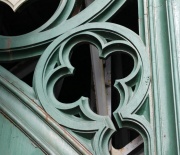Great Western Bridge (Glasgow)















Carries the busy Great Western Road over the River Kelvin, linking Glasgow and Hillhead.
Opened in 1891, it is a late and magnificent example of a cast iron arch bridge.
Immediately upstream may be seen some remains of an earlier stone bridge. This passed at an angle to the line of the current bridge and its masonry predecessor. The two masonry bridges may be seen in a Victorian photograph in the CANMORE website.
1889 Contracts placed. Foundation stone laying ceremony took place in April 1890. The Engineers were Bell and Miller, the masonry contractors Morrison and Mason. William Arrol and Co were the contractors for the iron and steelwork.[1]
The abutments are constructed from sandstone, brick and granite.
The designers negotiated the awkward crossing over the meandering river - and a small roadway and a footpath - by two main arches of 91 ft and two smaller arches of 34 ft.
The eastern approach is served by an impressive cast iron stairway leading to South Woodside Road and the entrance to Kelvinbridge subway station.
The CANMORE website summarises information from a number of authoratitive sources and provides maps and photographs[2]. One source states that the western abutment overlies old shallow coal workings and is carried on a steel frame resting on cast-iron columns which penetrate the workings to provide a secure foundation. From Engineering:-
1890 'Only in the case of the west abutment was any difficulty experienced. Here the foundation is also on the rock : but the borings indicated that the coal waste, known to be present throughout a great part of the district, extended for a short distance under the bed of the river beyond the west abutment pier. When the former bridge was widened it was considered necessary to take special precautions with the foundations of the west abutment pier, and accordingly 10-in. holes were bored through the rock which formed the roof of the coal working, and a series of 8 in. cast-iron columns put through these down to the floor of the coal working, so as to secure a solid bed. These pillars were 21 ft. long, and were connected at the top by strong iron beams and a platform, and the masonry built upon them. The hollow space of the working was 4 ft. deep. These pillars and crossbeams have been retained in position, and the masonry abutments of the new pier built on them. As an additional precaution it was considered desirable to use wrought-iron frames bedded and securely built into the masonry, to distribute the pressure more equally on the west abutment. These frames consisted of 2 H girders 3 ft. 3 in. deep, both flanges being 15 in. by 3/8 in. connected to a web 3/8 in. thick by angles 3 1/2 in. by 3/8 in. thick. These H girders are placed 3 ft. apart between centres and are connected together opposite each main girder by a wrought-iron diaphragm stiffened with angles. To this frame is firmly bolted the cast iron skewbacks for bedding the girders for the arch. ....'[3]
Some of the water mains bringing water from Loch Katrine had passed over the old bridge, and provision had to be made in the new structure for them, the bridge being designed to carry two lines of water mains of 3 ft. internal diameter, under the roadway and space was also provided for gas pipes. Pipes are visible in some of the photographs opposite.
See Also
Sources of Information
- ↑ The Scotsman, 10 April 1890
- ↑ [1] CANMORE website: 'Glasgow, Great Western Road, Great Western Bridge'
- ↑ Engineering 1890/08/22

